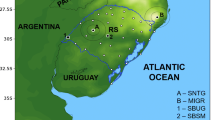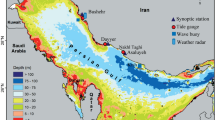Abstract
A bow echo is a type of mesoscale convective phenomenon that often induces extreme weather and appears with strong reflectivity on radar images. A strong bow echo that developed from a supercell was observed over Foshan City in southern China on 17 April 2011. The intense gusty winds and showers caused huge losses of property and severely affected human lives. This paper presents an analysis of this strong meso-β-scale convective system based on Doppler radar observations. The isolated bow echo exhibited a horizontal scale of about 80 km in terms of reflectivity above 40 dBZ, and a life span of 8 hours. The system originated from the merging of a couple of weakly organized cells in a shear line, and developed into an arch shape as it moved through the shear zone. Sufficient surface moisture supply ensured the convective instability and development of the bow echo. The low-altitude winds retrieved from single Doppler radar observations showed an obvious rear-inflow jet along the notch area. Different from the conventional definition, no bookend anticyclone was observed throughout the life cycle. Very strong slantwise updrafts and downdrafts were recognizable from the retrieved winds, even though the spatial scale of the bow echo was small. Strong winds and induced damage on the surface are considered to have been caused by the mid-level rear-inflow jet and intense convective downdrafts.
Similar content being viewed by others
References
Adams-Selin, R. D., and R. H. Johnson, 2010: Mesoscale surface pressure and temperature features associated with bow echoes. Mon. Wea. Rev., 138, 212–227.
Atkins, N. T., and M. St. Laurent, 2009: Bow echo mesovortices. Part I: Processes that influence their damaging potential. Mon. Wea. Rev., 137, 1497–1513.
Atkins, N. T., J. M. Arnott, R. W. Przybylinski, R. A. Wolf, and B. D. Ketcham, 2004: Vortex structure and evolution within bow echoes. Part I: Single Doppler and damage analysis of the 29 June 1998 Derecho. Mon. Wea. Rev., 132, 2224–2242.
Businger, S., T. Birchard Jr., K. Kodama, P. A. Jendrowski, and J.-J. Wang, 1998: A bow echo and severe weather associated with a Kona low in Hawaii. Wea. Forecasting, 13, 576–591.
Davis, C., and Coauthors, 2004: The bow echo and MCV experiment, observations and opportunities. Bull. Amer. Meteor. Soc., 85, 1075–1099.
Finley, C. A., W. R. Cotton, and R. A. Pielke Sr., 2001: Numerical simulation of tornadogenesis in a high-precipitation supercell, Part 1: Storm evolution and transition into a bow echo. J. Atmos. Sci., 58, 1597–1629.
Fujita, T. T., 1978: Manual of downburst identification for project NIMROD. Satellite and mesometeorology Research Paper 156, Dept. of Geophysical Sciences, University of Chicago, 104pp.
Johns, R. H., 1993: Meteorological conditions associated with bow echo development in convective storms. Wea. Forecasting, 8, 294–299.
Jorgensen, D. P., and B. F. Smull, 1993: Mesovotex circulation seen by airborne Doppler radar within a bow echo MCS. Bull. Amer. Meteor. Soc., 74, 2146–2157.
Klimowski, B. A., M. R. Hjelmfelt, and M. J. Bunkers, 2004: Radar observations of the early evolution of bow echoes. Wea. Forecasting, 19, 727–734.
Lee, W. C., R. M. Wakimoto, and R. E. Carbone, 1992: The evolution and structure of a “bow-echo microburst”event. Part II: The bow echo. Mon. Wea. Rev., 120, 2211–2225.
Przybylinski, R. W., 1995: The bow echo: Observations, numerical simulations, and severe weather detection methods. Wea. Forecasting, 10, 203–218.
Qiu, C.-J., and Q. Xu, 1992: A simple adjoint method of wind analysis for single-Doppler data. J. Atmos. Oceanic Technol., 9, 588–598.
Skamarock, W. C., M. L. Weisman, and J. P. Klemp, 1994: Three dimensional evolution of simulated longlive squall lines. J. Atmos. Sci., 51, 2563–2584.
Smull, B. F., and R. A. Houze Jr., 1987: Rear inflow in squall lines with trailing stratiform precipitation. Mon. Wea. Rev., 115, 2869–2889.
Wakimoto, R. M., H. V. Murphey, A. Nester, D. P. Jorgensen, and N. T. Atkins, 2006a: High winds generated by bow echoes. Part I: Overview of the Omaha bow echo 5 July 2003 storm during BAMEX. Mon. Wea. Rev., 134, 2793–2812.
Wakimoto, R. M., H. V. Murphey, C. A. Davis, and N. T. Atkins, 2006b: High winds generated by bow echoes. Part II: The relationship between mesovortices and damaging straight-line winds. Mon. Wea. Rev., 134, 2813–2829.
Wheatley, D. M., R. J. Trapp, and N. T. Atkins, 2006: Radar and damage analysis of severe bow echoes observed during BAMEX. Mon. Wea. Rev., 134, 791–806.
Weisman, M. L., 1992: The role of convectively generated rear-inflow jets in the evolution of long-lived mesoconvective systems. J. Atmos. Sci., 49, 1826–1847.
Weisman, M. L., 1993: The genesis of severe, long-lived bow echoes. J. Atmos. Sci., 50, 645–670.
Wolf, P. L., 1998: WSR-88D radar depiction of supercell—bow echo interaction: Unexpected evolution of a large, tornadic, “comma-shaped” supercell over eastern Oklahoma. Wea. Forecasting, 13, 492–504.
Xu, Q., C.-J. Qiu, and J.-Y. Yu, 1995: Simple adjoint retrievals of microburst winds from single-Doppler radar data. Mon. Wea. Rev., 123, 1822–1833.
Zhang, R., Y. Ni, L. Liu, Y. Luo, and Y. Wang, 2010: South China heavy rainfall experiments (SCHeREX). J. Meteor. Soc. Japan, 89A, 153–166.
Author information
Authors and Affiliations
Corresponding author
Rights and permissions
About this article
Cite this article
Peng, X., Zhang, R. & Wang, H. Kinematic features of a bow echo in southern China observed with Doppler radar. Adv. Atmos. Sci. 30, 1535–1548 (2013). https://doi.org/10.1007/s00376-012-2108-6
Received:
Revised:
Accepted:
Published:
Issue Date:
DOI: https://doi.org/10.1007/s00376-012-2108-6




